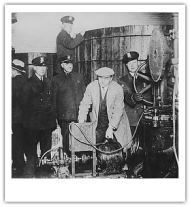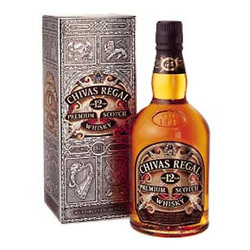
The Volstead act or Prohibition act took effect in 1920. In several states in America laws were already set up in an attempt to halt the use of alcohol. These laws were in place ahead of the 18th amendment (Volstead act, Prohibition act) was passed before congress.
New York was the first state to possess any such laws passed in 1697. This law basically stated that saloons and alcohol consumption facilities have to close on Sunday. Sunday for most religions is meant to be considered a day of rest and prayer rather than drinking. In Georgia around 1735, the government passed its 1st state wide ban on alcohol. The ban endured only seven years and was a complete failure.
In 1851, they tried once again to instill a prohibition on alcohol in Maine, this time it worked even better than they had hoped. By 1855, a dozen other states joined Maine in becoming what is known as a "dry state."
Following the Civil War in 1880, women of all ages joined the "dries". It wasn't long before the temperance movement had become a power to be noticed. The conservative Woman's Christian Temperance Union, WCTU, was formed and the Prohibition Party began gaining steam.
By 1900, greater than 50% of the continental United States was dry. The prohibitionists believed they had the alcohol ban secured and there was not any possible way for anyone to get alcohol in a dry state. Regrettably for the dries, the US Postal Service unintentionally provided a loophole. Because the USPS was managed by the federal government not the state government, liquor could be ordered and shipped by a wet state. This maddened the dries. In 1913, an Interstate Liquor Act was approved. This act effectively made it illegal for anybody to mail liquor to any dry state in anyway. The results was actually a step backwards for those trying to keep liquor out because it gave rise to much more illegal ways of getting the alcohol as liquor distilleries were now in league with organized crime.
In 1917, the 18th amendment was drafted rendering it illegal to purchase, send or produce liquor. This wouldn't sit well with a lot of states. The amendment was debated in congress for an additional 2 years. In 1920 Thirty-three states had declared themselves dry which meant a major victory for the prohibition party.
January 29, 1919. The 18th Amendment was ratified making all hard liquor with an ethanol content more than 80 proof (40%) be disallowed. Legally, it banned the production, selling, or transporting of such alcoholic beverages. This was backed by many people since they thought that only hard liquor was to be banned and that it would be okay to have a glass of wine with food or a beer after work. Even so, it wasn't until 12 months later, the Volstead Act (prohibition act) was approved. The Volstead Act completely banned all alcohol that had greater than 1 proof (1/2%) of alcohol. This essentially banned all styles of alcoholic beverages, except for non-alcoholic beers. After the 18th amendment was ratified, the Volstead Act was brought into the light by the Prohibition enthusiasts. For almost all of the prohibition supporters who only wanted a little wine or the odd beer believed they had been tricked since they wound up with absolutely nothing after the act was passed.
One group that no one thought of were the veterans of World War 1. These soldiers felt very betrayed coming back home from battling in the war. The majority of them had been stationed in France and came to know how a moderate quantity of alcohol could enhance the quality of life. Returning home and learning that the dries had won an absolute victory over alcohol compounded the bitterness of the veterans disdain. The fatal mistake with prohibition was to ban all varieties of alcohol. Eighty percent of the Prohibition Party supporters got out of the party. Prohibition continued for 13 years in the United states until in 1933 the 21st amendment was passed to officially end the ban on alcohol.
Do you want to uncover more about making whiskey? Check out How To make Whiskey HQ. There you will locate mash recipes, equipment information and facts and detailed step by step instructions for how to make whiskey.
New York was the first state to possess any such laws passed in 1697. This law basically stated that saloons and alcohol consumption facilities have to close on Sunday. Sunday for most religions is meant to be considered a day of rest and prayer rather than drinking. In Georgia around 1735, the government passed its 1st state wide ban on alcohol. The ban endured only seven years and was a complete failure.
In 1851, they tried once again to instill a prohibition on alcohol in Maine, this time it worked even better than they had hoped. By 1855, a dozen other states joined Maine in becoming what is known as a "dry state."
Following the Civil War in 1880, women of all ages joined the "dries". It wasn't long before the temperance movement had become a power to be noticed. The conservative Woman's Christian Temperance Union, WCTU, was formed and the Prohibition Party began gaining steam.
By 1900, greater than 50% of the continental United States was dry. The prohibitionists believed they had the alcohol ban secured and there was not any possible way for anyone to get alcohol in a dry state. Regrettably for the dries, the US Postal Service unintentionally provided a loophole. Because the USPS was managed by the federal government not the state government, liquor could be ordered and shipped by a wet state. This maddened the dries. In 1913, an Interstate Liquor Act was approved. This act effectively made it illegal for anybody to mail liquor to any dry state in anyway. The results was actually a step backwards for those trying to keep liquor out because it gave rise to much more illegal ways of getting the alcohol as liquor distilleries were now in league with organized crime.
In 1917, the 18th amendment was drafted rendering it illegal to purchase, send or produce liquor. This wouldn't sit well with a lot of states. The amendment was debated in congress for an additional 2 years. In 1920 Thirty-three states had declared themselves dry which meant a major victory for the prohibition party.
January 29, 1919. The 18th Amendment was ratified making all hard liquor with an ethanol content more than 80 proof (40%) be disallowed. Legally, it banned the production, selling, or transporting of such alcoholic beverages. This was backed by many people since they thought that only hard liquor was to be banned and that it would be okay to have a glass of wine with food or a beer after work. Even so, it wasn't until 12 months later, the Volstead Act (prohibition act) was approved. The Volstead Act completely banned all alcohol that had greater than 1 proof (1/2%) of alcohol. This essentially banned all styles of alcoholic beverages, except for non-alcoholic beers. After the 18th amendment was ratified, the Volstead Act was brought into the light by the Prohibition enthusiasts. For almost all of the prohibition supporters who only wanted a little wine or the odd beer believed they had been tricked since they wound up with absolutely nothing after the act was passed.
One group that no one thought of were the veterans of World War 1. These soldiers felt very betrayed coming back home from battling in the war. The majority of them had been stationed in France and came to know how a moderate quantity of alcohol could enhance the quality of life. Returning home and learning that the dries had won an absolute victory over alcohol compounded the bitterness of the veterans disdain. The fatal mistake with prohibition was to ban all varieties of alcohol. Eighty percent of the Prohibition Party supporters got out of the party. Prohibition continued for 13 years in the United states until in 1933 the 21st amendment was passed to officially end the ban on alcohol.
Do you want to uncover more about making whiskey? Check out How To make Whiskey HQ. There you will locate mash recipes, equipment information and facts and detailed step by step instructions for how to make whiskey.

 RSS Feed
RSS Feed